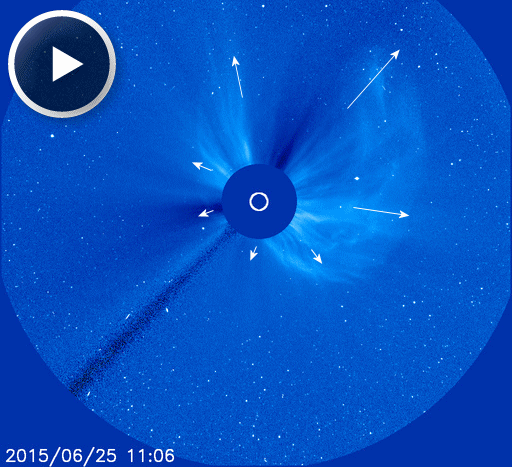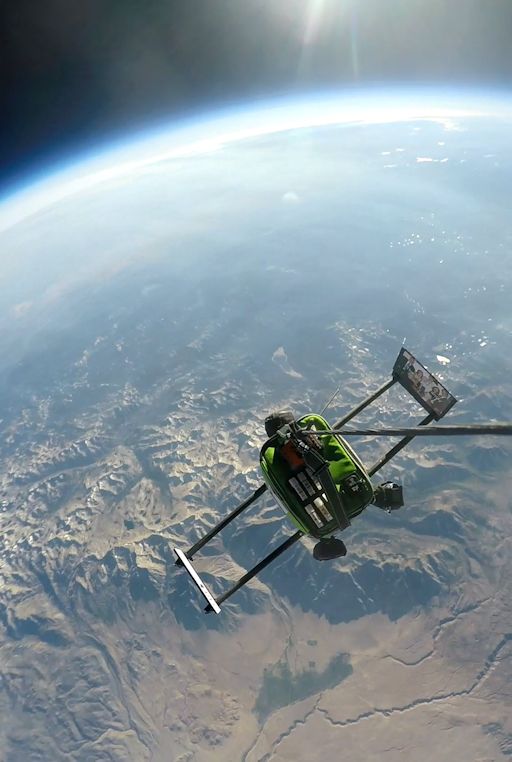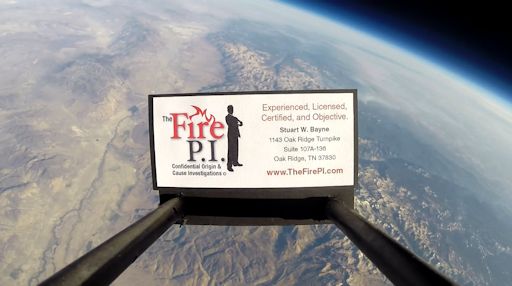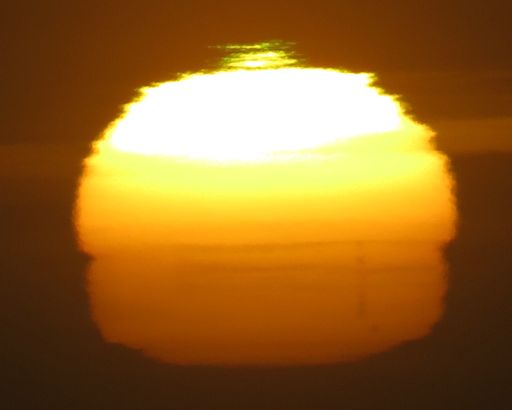Learn to photograph Northern Lights like a pro. Sign up for Peter Rosen's Aurora Photo Courses in Abisko National Park, winner of the TripAdvisor Certificate of Excellence Award 2015. | | |
CHANCE OF FLARES: Active sunspot AR2371 is decaying, but it still poses a threat for geoeffective explosions. The sunspot's unstable 'beta-gamma' magnetic field has erupted at least once a day for the past week. NOAA forecasters estimate a 60% chance of M-class flares and a 20% chance of X-flares on June 26th. Solar flare alerts: text or voice.
ANOTHER CME IS ON THE WAY: Since June 21st, four CMEs have hit Earth's magnetic field. A fifth is on the way. Sunspot AR2371 erupted again during the early hours of June 25th, producing an M7.9-class solar flare and a lopsided CME. The Solar and Heliospheric Observatory photograhed the storm cloud, which raced away from the sun faster than 2000 km/s (4.5 million mph):

The CME will hit Earth's magnetic field on June 27th, probably mid-day Universal Time. According to NOAA computer models there is a 79% chance of polar geomagnetic storms. High-latitude sky watchers should be alert for auroras. Aurora alerts: text or voice.
Realtime Aurora Photo Gallery
MUTATING MICROBES: Regular readers know that Spaceweather.com and the students of Earth to Sky Calculus have been launching microbes to the edge of space, more than half a dozen times since April. Carried aloft by helium balloons, halobacteria are now frequent fliers to the stratosphere. An early finding of this ongoing experiment is that the microbes are mutated during their trip, probably by exposure to galactic cosmic rays. Would they be mutated even more by a solar storm? That's what the students wanted to find out, so on June 22nd they launched a new batch of microbes during the strongest space weather event of 2015. Here is the payload 108,213 feet above Earth's surface:

At the time of the flight, a severe G4-class geomagnetic storm was underway. After nightfall, people would see auroras as far south as California and Arizona. In addition, a maelstrom of solar protons were bombarding Earth's magnetic field, producing a moderately-strong S2-class radiation storm.
Will any of this affect the mutation rate of the microbes? Microbiologists Shil and Priya DasSarma are culturing the halobacteria now in their NASA-funded laboratory at the University of Maryland. When their results are available and confirmed, we will share them.
Astrobiologists have a special interest in halobacteria. This extremophile has the ability to shield itself from harmful radiation and to repair damaged DNA. Researchers have speculated that it might be able to survive on the planet Mars. The temperature, air pressure, and radiation environment in Earth's stratosphere is similar to Mars, so a balloon flight is a good way to test halobacteria's "Red Planet readiness." Stay tuned for results!
HEY THANKS: All of the high-altitude astrobiology research featured on Spaceweather.com is crowd-funded. This particular flight was sponsored by Stuart Bayne, a.k.a. The Fire P.I., an expert investigator of fires and explosions. Here is his logo at the apex of the flight:

His generous donation of $500 paid for the helium, the balloon, and other supplies required to get this mission off the ground. In return, he will receive a full-length HD video of the flight. Thanks, Stuart!
Readers, would you like to sponsor a research flight and see your favorite photo or business logo at the edge of space? If so, please contact Dr. Tony Phillips to make arrangements.
GREEN SLICES OF SUNSHINE: Photographer Mila Zinkova of San Francisco was watching the sunset on June 24th when a few slices of the sun lifted off and turned green. "It was an amazing green flash," she says:

Atmospheric optics expert Les Cowley explains: "All green flashes are mirages.The setting sun's rays bend as they slant across air layers at different temperatures. When the bending is strong enough we see multiple images. But the images are slices rather than complete suns. Some are the right way up and sink with the setting sun while others are inverted and climb upwards. In Mila's complex sunset, several mirage slices show the same sunspot (AR2371), while the very topmost slice magnifies the ordinarily invisible green rim into a green flash."
Look for more sun-shots in the space weather photo gallery:
Realtime Space Weather Photo Gallery
Realtime NLC Photo Gallery
Realtime Sprite Photo Gallery
Every night, a network of NASA all-sky cameras scans the skies above the United States for meteoritic fireballs. Automated software maintained by NASA's Meteoroid Environment Office calculates their orbits, velocity, penetration depth in Earth's atmosphere and many other characteristics. Daily results are presented here on Spaceweather.com.
On Jun. 26, 2015, the network reported 14 fireballs.
(13 sporadics, 1 Northern June Aquilid)

In this diagram of the inner solar system, all of the fireball orbits intersect at a single point--Earth. The orbits are color-coded by velocity, from slow (red) to fast (blue). [Larger image] [movies]
Potentially Hazardous Asteroids (
PHAs) are space rocks larger than approximately 100m that can come closer to Earth than 0.05 AU. None of the known PHAs is on a collision course with our planet, although astronomers are finding
new ones all the time.
On June 26, 2015 there were 1592 potentially hazardous asteroids.
Notes: LD means "Lunar Distance." 1 LD = 384,401 km, the distance between Earth and the Moon. 1 LD also equals 0.00256 AU. MAG is the visual magnitude of the asteroid on the date of closest approach. | | The official U.S. government space weather bureau |
| | The first place to look for information about sundogs, pillars, rainbows and related phenomena. |
| | Researchers call it a "Hubble for the sun." SDO is the most advanced solar observatory ever. |
| | 3D views of the sun from NASA's Solar and Terrestrial Relations Observatory |
| | Realtime and archival images of the Sun from SOHO. |
| | from the NOAA Space Environment Center |
| | the underlying science of space weather |
| | Web-based high school science course with free enrollment |

